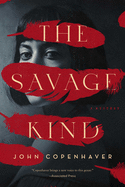
A gripping coming-of-age story set in 1948 propels the character-driven The Savage Kind, which explores the unresolved sexual attraction between two teenage outcasts, quiet Philippa Watson and opinionated Judy Peabody. John Copenhaver's second novel (after the Macavity Award-winning Dodging and Burning) captures the awkwardness of teenagers grappling with identity and a need to belong.
Philippa recently moved to Washington, D.C., with her loving father, a lawyer with JAG (Judge Advocate General's) Corps, and kind stepmother; Judy maintains a volatile relationship with her adopted parents. The girls' initially tentative friendship deepens, fueled by their love of Romantic poets, classic literature and a mutual infatuation with Christine Martins, their perceptive and beautiful English teacher at Eastern High. Returning a book to Christine's apartment, Philippa flees after seeing the teacher and a half-dressed man in bed. Philippa is unsure if she witnessed an affair or an attack. Then Christine abruptly resigns, and the body of a student with whom she had fought is found. Philippa and Judy go all Nancy Drew to find out what happened, especially since the student's murder echoes the unsolved killing of the Peabodys' biological daughter.
The teens' growing sexual awakening and hunger for romance deepen Copenhaver's solid character studies as he shows two complicated, brilliant young women wrestling with pending adulthood and sexuality. A prologue by an anonymous voice, points of view from each teenager, along with diary entries, add to the tension: Whose remembrances are to be trusted? The finale becomes unwieldy, however, with a few too many turns. Still, Copenhaver excels in shaping characters on the cusp of acknowledging they are gay in The Savage Kind. --Oline H. Cogdill, freelance reviewer

